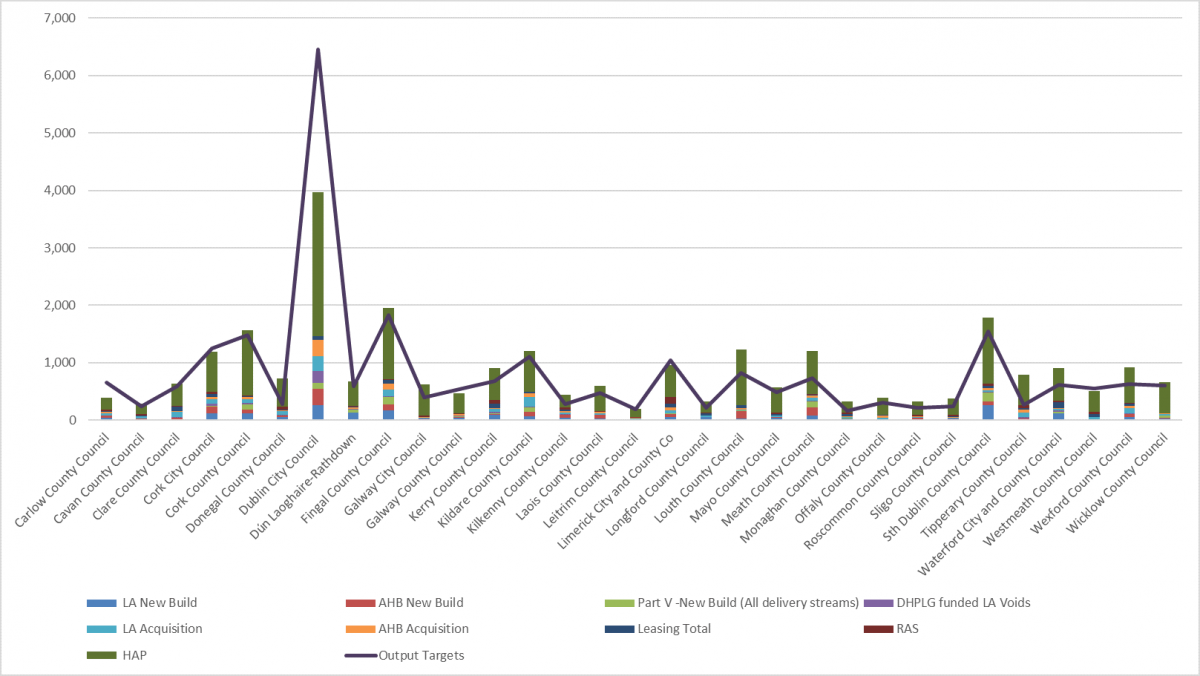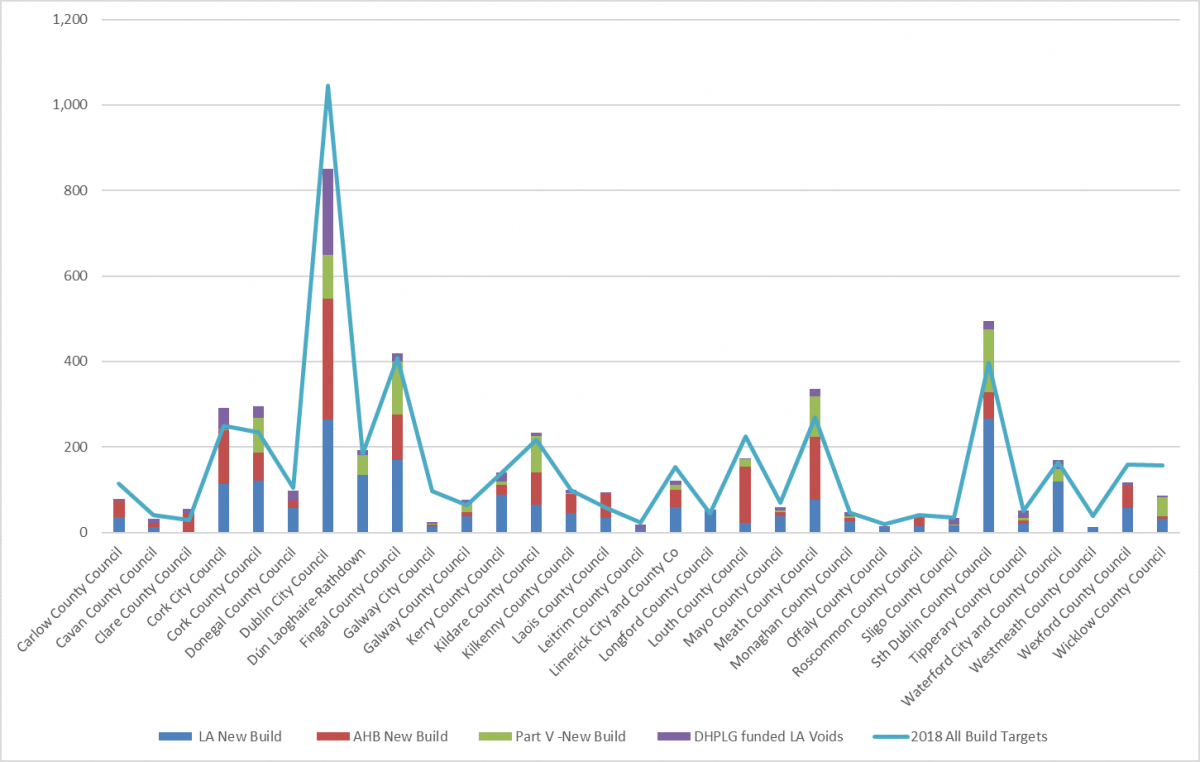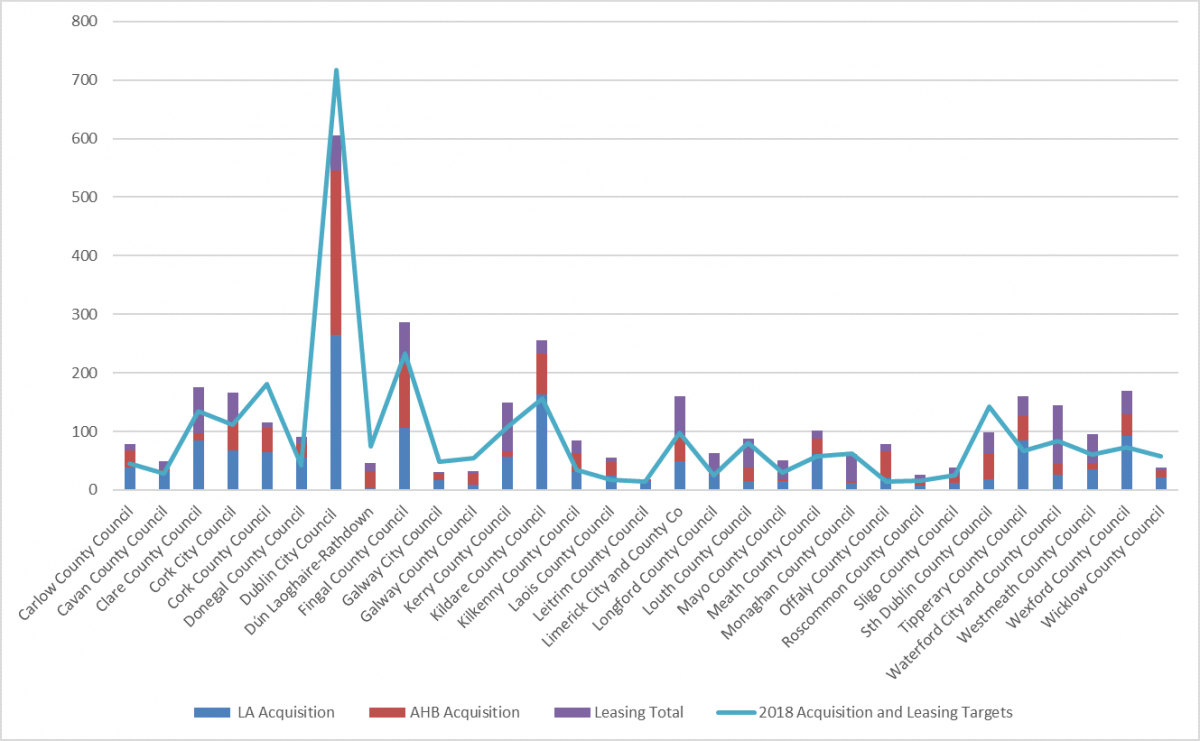45% of Local Authorities fail to meet social housing build targets while private sector dominates

Last week the Department of Housing, Planning and Local Government published a breakdown of Social Housing Output by local authority area. This showed that 45% of all local authorities failed to meet their build targets last year, with Galway City Council only providing a quarter of its target builds and Westmeath County Council providing just over a third. The Housing Assistance Payment (HAP), a subsidy to landlords in the private rented sector, continued to outpace the provision of long-term sustainable homes, accounting for 66% of all Social Housing Output in the reporting period.
Chart 1 shows the composition of Social Housing Output for each Local Authority area compared to the target output for that local authority. On this basis, just 6 of the 31 local authorities failed to meet their targets, and even those met 60% or over.
Chart 1: Social Housing Output by Type and Targets, Q3 2018

Source: Social Housing Output Overview by LA, Department of Housing, Planning and Local Government
Chart 2, which isolates the ‘build’ data and associated targets, shows a different picture. Here you will see that the number of Local Authorities who missed their targets was more than double that indicated in the previous Chart, with the provision of long-term, sustainable social housing under-built in 14 of the 31 Local Authority areas.
Chart 2: ‘All Builds’ by Build Type and Targets, Q3 2018

Source: Social Housing Output Overview by LA, Department of Housing, Planning and Local Government
The numbers acquired and leased, compared to the targets set in this area, fared better in terms of targets reached. As can be seen in Chart 3, targets were exceeded in all but 8 Local Authority areas. Actual Acquisitions and Leases in most areas which exceeded targets were 100-250% of target, with Offaly being over 550%, albeit from a low target of 14. In terms of the actual number of units provided through this method, more social housing units were provided through Acquisitions and Leasing than actual builds (including Regeneration) in 14 of the 31 Local Authority areas.
Speed of delivery is likely a contributing factor in why Acquisitions and Leases are outperforming their targets, however in many areas this would be a more expensive form of housing provision compared to Local Authorities and Approved Housing Buildings, particularly if using State lands. The continuing cost to the Exchequer must also be a factor in determining the best method and it is time that a full comparative long-term cost analysis is developed.
Chart 3: Acquisitions and Leasing by Type and Target, Q3 2018

Source: Social Housing Output Overview by LA, Department of Housing, Planning and Local Government
As can be seen in Table 1, the proportion of Social Housing Output attributed to HAP can be as much as 86%, with those Local Authorities at the lower end of the scale still providing almost half of their social housing through this method. It is interesting to note that Galway City Council, which met the smallest proportion of its build target (just 25%), had the highest proportion of Social Housing Output attributed to HAP.
Table 1: Delivery Method as % of all Social Housing Output per Local Authority, Q3 2018

Source: Social Housing Output Overview by LA, Department of Housing, Planning and Local Government
Local Authorities and Local Representatives must be accountable for their budgetary decisions in the midst of a housing crisis, both to their immediate constituents and to the wider population who will feel the impact of poor Exchequer decisions, which look to the short-term rather than plan for the future. Questions must be asked as to the sustainability, and reliability, of a private subsidy in the provision of long-term homes.
In their publication this month, entitled ‘Institutional Investment in the Housing Market’, the Department of Finance points to the growth of institutional investment as “the result of a structural change in the market” (p.21) while also pointing to an increase in Residential Investment Activity in 2014 and onwards (p.18, Figure 10). This did not happen in a vacuum. The passing of REIT (Real Estate Investment Trusts) legislation in 2013 and the introduction of HAP in September 2014 likely played their part. Government policy has prioritised property speculation over the needs of its most vulnerable. Those implementing these policies must now be held to account.

GIVING A VOICE TO THOSE
WHO DON’T HAVE A VOICE
When you support Social Justice Ireland, you are tackling the causes of problems.
